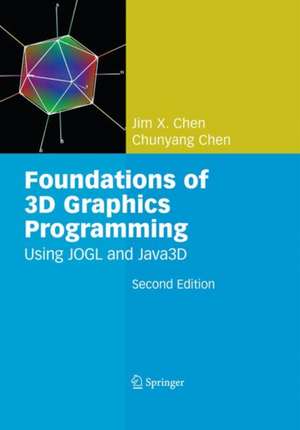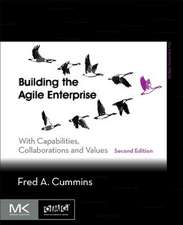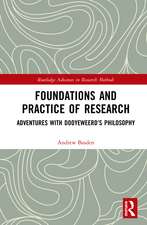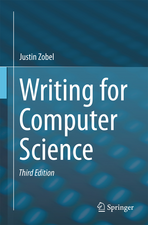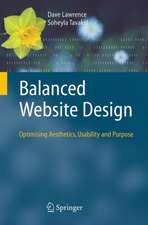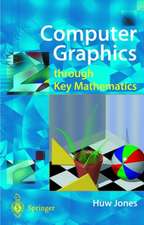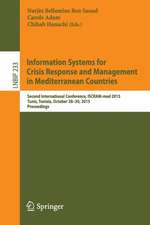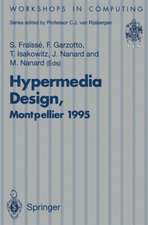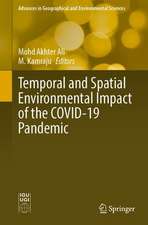Foundations of 3D Graphics Programming: Using JOGL and Java3D
Autor Jim X. Chen, Chunyang Chenen Limba Engleză Hardback – 11 sep 2008
| Toate formatele și edițiile | Preț | Express |
|---|---|---|
| Paperback (1) | 540.47 lei 6-8 săpt. | |
| SPRINGER LONDON – 23 aug 2016 | 540.47 lei 6-8 săpt. | |
| Hardback (1) | 608.48 lei 38-44 zile | |
| SPRINGER LONDON – 11 sep 2008 | 608.48 lei 38-44 zile |
Preț: 608.48 lei
Preț vechi: 760.60 lei
-20% Nou
Puncte Express: 913
Preț estimativ în valută:
116.45€ • 120.13$ • 98.56£
116.45€ • 120.13$ • 98.56£
Carte tipărită la comandă
Livrare economică 01-07 martie
Preluare comenzi: 021 569.72.76
Specificații
ISBN-13: 9781848002838
ISBN-10: 1848002831
Pagini: 408
Ilustrații: XVI, 386 p.
Greutate: 0.84 kg
Ediția:2nd ed. 2008
Editura: SPRINGER LONDON
Colecția Springer
Locul publicării:London, United Kingdom
ISBN-10: 1848002831
Pagini: 408
Ilustrații: XVI, 386 p.
Greutate: 0.84 kg
Ediția:2nd ed. 2008
Editura: SPRINGER LONDON
Colecția Springer
Locul publicării:London, United Kingdom
Public țintă
GraduateCuprins
Transformation and Viewing.- Color and Lighting.- Blending and Texture Mapping.- Curved Models.- Vertex Shading, Pixel Shading, and Parallel Processing.- Cg Programming.- Programming in Java3D.- Advanced Topics.
Recenzii
From the reviews of the second edition:
"This book is primarily a survey of the basic, traditional computer graphics topics taught in many algorithm-oriented computer graphics courses … . all of the example code provided in the textbook is written in Java, using OpenGL. … Since many institutions have moved to the Java programming language, this is a very reasonable choice. … Overall, I like the textbook … . chapters of the textbook constitute a typical one-semester introduction to a graphics overview course of 2D and 3D graphics (rendering side)." (J. Miller, ACM Computing Reviews, June, 2009)
"This book is primarily a survey of the basic, traditional computer graphics topics taught in many algorithm-oriented computer graphics courses … . all of the example code provided in the textbook is written in Java, using OpenGL. … Since many institutions have moved to the Java programming language, this is a very reasonable choice. … Overall, I like the textbook … . chapters of the textbook constitute a typical one-semester introduction to a graphics overview course of 2D and 3D graphics (rendering side)." (J. Miller, ACM Computing Reviews, June, 2009)
Textul de pe ultima copertă
"A good, concise computer graphics textbook covering 3D concepts, essential fundamentals theory, and easy-to-follow OpenGL practical programming in Java."
Dr. Jack Bresenham, Retired IBM Senior Technical Staff Member
Increasingly in the realms of science and industry, computer graphics is an area of critical importance and utility. And within the graphics community, the demand for producing exceptional 3D graphics in particular is almost a given.
This thoroughly updated and enhanced second edition of Foundations of 3D Graphics Programming is an innovative shortcut to graphics theory and programming using JOGL, a new vehicle of 3D graphics programming in Java. This revised edition of the successful, reader-friendly text covers all graphics basics and several advanced topics, as well as some basic concepts in Java programming for those who currently are C/C++ programmers. Specifically, it provides all the core aspects of OpenGL programming in Java using JOGL, along with concisely presented computer graphics theories. In addition, it uses a top-down approach to lead the reader into programming and applications up-front. The content about theory provides a high-level understanding of all basic graphics, and of using JOGL instead of implementing a graphics system. Explanations are integrated with the sample programs, which are specifically designed for learning and accompanying this book.
Topics and Features:
• Presents 2 new chapters covering vertex shading, pixel shading and parallel processing, and Cg programming [NEW]
• Introduces a shortcut to 3D graphics theory, and serves as a concise guide to both theory and programming
• Contains additional new material, such as a look at advanced effects in Cg programming [NEW]
• Covers JOGL, a new vehicle of 3D graphics programming in Java, with extensive andcomplete examples
• Incorporates numerous practical examples and exercises
• Provides a new appendix for Basic Mathematics for 3D Graphics [NEW]
• Introduces and describes Java3D, a shortcut to high-level 3D graphics APIs in Java, with detailed example programs
• Provides readers with comprehensive samples in JOGL and Java3D
• Offers a supplementary website with updates, sample programs, figures, and useful weblinks and instructions for setting up the OpenGL programming environment
Written by a leader in 3D graphics, virtual experience, and statistical data visualization, this text/reference is a comprehensive, yet concise volume intended for scientists and engineers who understand Java programming. Moreover, it is a good reference for C/C++ graphics programmers interested in learning Java and JOGL. Accessible for an interdisciplinary readership, this book requires only basic knowledge of vector analysis and programming, and as such is highly suitable for classroom use.
Key Topics
• Geometric Transformation
• Lighting and Shading
• Blending and Texture Mapping
• Curved Models
• Programming in Java 3D
• Animation and Simulation
• Vertex Shading and Parallel Processing
• Cg Programming
Dr. Jack Bresenham, Retired IBM Senior Technical Staff Member
Increasingly in the realms of science and industry, computer graphics is an area of critical importance and utility. And within the graphics community, the demand for producing exceptional 3D graphics in particular is almost a given.
This thoroughly updated and enhanced second edition of Foundations of 3D Graphics Programming is an innovative shortcut to graphics theory and programming using JOGL, a new vehicle of 3D graphics programming in Java. This revised edition of the successful, reader-friendly text covers all graphics basics and several advanced topics, as well as some basic concepts in Java programming for those who currently are C/C++ programmers. Specifically, it provides all the core aspects of OpenGL programming in Java using JOGL, along with concisely presented computer graphics theories. In addition, it uses a top-down approach to lead the reader into programming and applications up-front. The content about theory provides a high-level understanding of all basic graphics, and of using JOGL instead of implementing a graphics system. Explanations are integrated with the sample programs, which are specifically designed for learning and accompanying this book.
Topics and Features:
• Presents 2 new chapters covering vertex shading, pixel shading and parallel processing, and Cg programming [NEW]
• Introduces a shortcut to 3D graphics theory, and serves as a concise guide to both theory and programming
• Contains additional new material, such as a look at advanced effects in Cg programming [NEW]
• Covers JOGL, a new vehicle of 3D graphics programming in Java, with extensive andcomplete examples
• Incorporates numerous practical examples and exercises
• Provides a new appendix for Basic Mathematics for 3D Graphics [NEW]
• Introduces and describes Java3D, a shortcut to high-level 3D graphics APIs in Java, with detailed example programs
• Provides readers with comprehensive samples in JOGL and Java3D
• Offers a supplementary website with updates, sample programs, figures, and useful weblinks and instructions for setting up the OpenGL programming environment
Written by a leader in 3D graphics, virtual experience, and statistical data visualization, this text/reference is a comprehensive, yet concise volume intended for scientists and engineers who understand Java programming. Moreover, it is a good reference for C/C++ graphics programmers interested in learning Java and JOGL. Accessible for an interdisciplinary readership, this book requires only basic knowledge of vector analysis and programming, and as such is highly suitable for classroom use.
Key Topics
• Geometric Transformation
• Lighting and Shading
• Blending and Texture Mapping
• Curved Models
• Programming in Java 3D
• Animation and Simulation
• Vertex Shading and Parallel Processing
• Cg Programming
Caracteristici
This second edition contains 3 new chapters, a new appendix and is updated and enhanced throughout Supreme reference on JOGL programming, with extensive and complete examples Also covers Java3D, with detailed example programs Serves as an ideal shortcut to 3D graphics theory Written by a recognized leader in 3D graphics, virtual experiences and statistical data visualization, based on years of teaching and research experience
